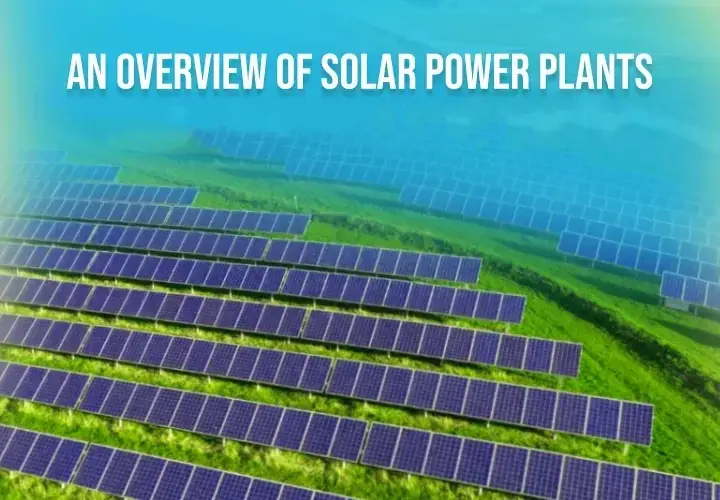
In recent years, the global shift towards more renewable energy sources has gained more significance, and solar power has emerged as a leading source in the race to reduce carbon emissions and combat climate change. Solar power plants and their ability to harness the sun’s energy and convert it into electricity have become essential in the path of transitioning to a sustainable energy future. As we navigate through this transition, a comprehensive understanding about solar power plants, their types, and their various facets is important. In this blog, we will explore the different types of solar power plants and other relevant features.
What are Solar Power Plants
Solar Power Plants, also known as solar farms, are large-scale facilities that are capable of generating electricity by converting sunlight into electrical energy. They generate more electricity when the earth receives maximum sunlight. They also generate power by burning fossil fuel to produce steam, which drives the turbines to produce electricity.
They help in keeping the environment pollution-free and to save energy. They are constructed with four main components panels, inverters, racking, and solar battery storage units. They come in various types and use photovoltaic (PV) modules, solar panels, or concentrated solar power (CSP) systems for energy conversion.
Photovoltaic (PV) Solar Power Plants:
Photovoltaic (PV) Solar Power Plants represent the most prevalent forms of solar energy systems. They utilize solar panels that are equipped with photovoltaic cells to convert sunlight directly into electricity. These plants can range from small-scale rooftops to large-utility solar farms. With the increasing demand, numerous companies, including leading solar PV consultants in India, are active in producing solar PV energy solutions.
Concentrated Solar Power (CSP) Plants:
CSP power plants use mirrors or lenses to concentrate sunlight onto a small area, which in turn generates heat to drive steam turbines for producing electricity. These solar power plants are often integrated with thermal energy storage systems, which enable them to generate power even during periods of limited sunlight. Other major components are solar field, and power block.
The solar field plays the main role in a CSP plant. It consists of reflectors that reflect and collect the sun’s radiation into a specific area known as “heat collection element” whereas the power block is the part where the thermal energy from the collector field is converted to electrical energy.
Solar Thermal Power Plants:
These power plants also employ mirrors to concentrate a large amount of sunlight into a smaller area. This sunlight is then used to heat a fluid, typically molten salt, which then generates steam and drives a turbine for electricity production. All solar thermal power plants are based on four basic essential systems which are collectors, absorbers(receiver), transport or storage and power conversions. Some technologies that are commercially available today are Parabolic Troughs, Solar Towers, Parabolic Dishes and Linear Fresnel Reflectors.
Pricing of Solar Power Plants:
The pricing of solar power plants can vary depending on several factors, like the scale of installation, technology used, geographic location, and local environment. Recently, there has been a decline in the cost of solar panels and associated equipment, which has made solar power an ultimate and affordable option to save energy. With advancements in technology, particularly in turnkey EPC solutions in India, many solar engineering companies have propelled towards cost-effective solar power plants without compromising on quality and expertise.
Subsidies and Incentives:
Governments and environmental agencies worldwide have been in crucial need of solar power in the transition to a cleaner, greener, and more sustainable ecosystem. To encourage and facilitate this shift, numerous subsidy programs and financial incentives have been implemented to support the costs of solar power plant installations. From tax credits to feed-in tariffs, these initiatives not only make solar power plants accessible but also stimulate customers to invest in renewable energy solutions, contributing to saving the earth.
Environmental Impacts:
Beyond the economic considerations, the environmental impact of switching to solar power is tremendous. With zero greenhouse gas emissions during operation, these power plants significantly reduce air and water pollution, resulting in clean air for the environment. Furthermore, the impact of solar power plants on land and water is relatively minimal compared to other forms of energy production. Solar panels can be installed on rooftops and open fields without disturbing any landscapes, and they do not rely on water for cooling or heat generation.
Future Prospects:
Looking ahead, with advancements in technology, the future of solar power plants appears promising. With the development of more solar EPC companies in India, it sets the stage for a sustainable future powered by an efficient, reliable energy source for a cleaner and greener world. To sum up, solar power plants play a major role in the global transition towards saving energy sources and sustainable living. To join this revolution, contact us to start your journey towards a sustainable environment.
In spite of the world moving fast to welcome solar energy as the optimal green alternative, people are still often intimidated by its maintenance and installation. As the Leading O&M Solution Provider, we believe that each one of our customers should receive the maximum production from their set-up. We provide many solutions for the Operation and Maintenance of Solar power plant to make the transition smoother and feasible for you. With our carefully crafted solutions, we believe you are bound to feel confident and satisfied with the abundant energy production.

